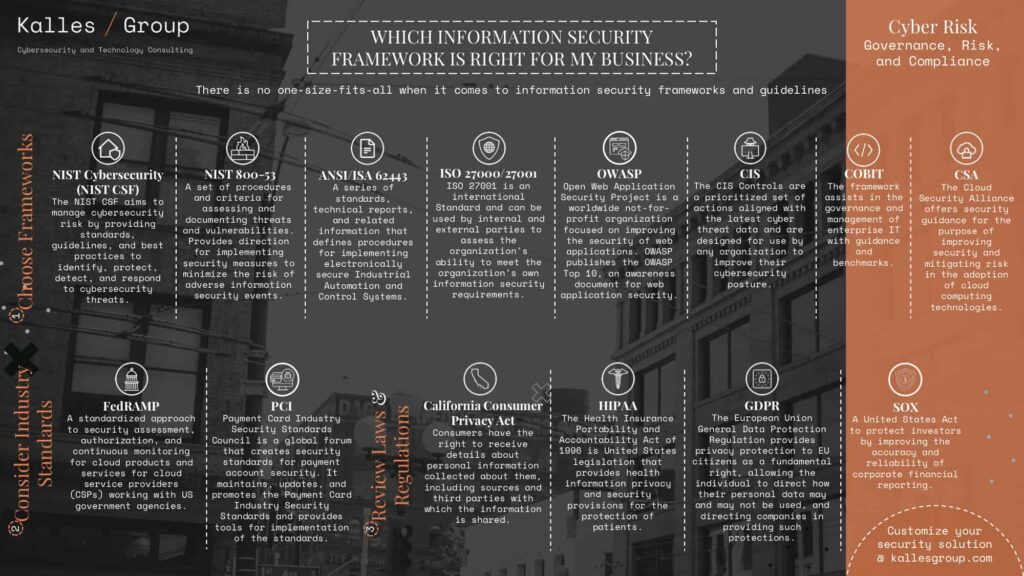Choosing the appropriate information security framework for your organization is important in protecting confidential or sensitive data, systems, and overall cyber resilience. With increasing regulatory requirements and an ever-evolving threat landscape, it is vital to devise a structured approach for safeguarding your assets and effectively managing your cyber risks.
The right information security framework provides a holistic set of guidelines, policies, and procedures for your organization’s unique objectives and requirements. The framework also serves as a roadmap for establishing formidable security measures, ensuring compliance with industry standards, and implementing a strong security posture.
If you’re new to the idea of security frameworks, it may be helpful to think about it as a structure that supports securing your digital assets and information.
However, with diverse frameworks available, such as NIST Cybersecurity Framework, ISO 27001, CIS Controls, and several others, figuring out the best fit for your organization can be hard. For instance, factors like your organization’s size, industry, regulatory environment, and risk tolerance all affect your decision.
In this comprehensive guide, we will explore the key considerations to enable you to identify the information security framework that suits your business needs. We will also discuss the available frameworks and how they can address your unique requirements.
*Spoiler alert–
There is no one-size-fits-all solution regarding information security frameworks and guidelines. No option exists that will solve all your risk mitigation and security problems or even a narrow slice of them- on its own. People must operationalize it. If you need support with this, we can help, but let’s start with an understanding of where to begin.

4 Steps to align the right information security framework with your unique needs.
There are 4 primary steps that you need to take to align the right information security framework with your organization’s unique customer and business outcomes.
Step 1: Understand which information security framework best aligns with your needs
If you’re new to the idea of security frameworks, it may be helpful to think about it as a structure that supports securing your digital assets and information. There are many types of information security frameworks for different purposes, but (at the risk of overgeneralizing) each is essentially a system of guidelines and best practices that will help you keep your organization secure. Depending on your industry, sector, business domain, and organizational profile, here are the most common industry-recognized frameworks to consider.
NIST Cybersecurity Framework (NIST CSF)
The National Institute of Standards and Technology (NIST) developed NIST CSF to manage cybersecurity risk by providing standards, guidelines, and best practices to identify, protect, detect, and respond to cybersecurity threats. NIST CSF covers critical infrastructure, but it has proven flexible enough for deployment by various companies across all industry sectors.
NIST 800-53
As part of the NIST Risk Management Framework (RMF), NIST 800-53 is a set of procedures and criteria for assessing and documenting threats and vulnerabilities. NIST 800-53 provides direction for implementing security measures to minimize the risk of adverse information security events.
ANSI/ISA 62443
ISA 62443 is a series of standards, technical reports, and related information that defines procedures for implementing electronically secure Industrial Automation and Control Systems. This applies to industrial communication networks, secure networks, embedded devices, and other relevant applications.
ISO 27000/27001
ISO 27001 is an international standard and can be used by internal and external parties to assess the organization’s ability to meet the organization’s information security requirements.
OWASP
Open Web Application Security Project is a worldwide not-for-profit organization focused on improving the security of web applications. OWASP publishes the OWASP TOP 10, an awareness document for web application security.
CIS
The Center for Internet Security (CIS) Controls are a prioritized set of actions aligned with the latest cyber threat data. CIS controls are useful for any organization in improving its cybersecurity posture.
COBIT
The COBIT framework assists in the governance and management of enterprise IT with guidance and benchmarks.
CSA
The Cloud Security Alliance (CSA) offers security guidance to improve security and mitigate risk in adopting cloud computing technologies.
Step 2: Consider industry standards
Depending on your scenario, there may be specific industry standards that you need to consider based on your product, service, and/or business operations.
FedRAMP
FedRAMP is a standardized approach to security assessment, authorization, and continuous monitoring of cloud products and services for cloud service providers (CSPs) working with US government agencies.
PCI
The Payment Card Industry (PCI) Security Standards Council is a global forum that creates security standards for payment account security. It maintains, updates, and promotes the Payment Card Industry Security Standards and provides tools for implementing them.
Step 3: Review laws and regulations
Some industries have clear regulatory requirements that must be adhered to, often requiring validation by audit or certification for ongoing compliance. But even if your business isn’t subject to specific regulations, it can be helpful to maintain an awareness of different regulatory requirements if your customers reside in specific geographic areas or you do business with a partner who does.
California Consumer Privacy Act (CCPA)
Consumers have the right to receive details about personal information collected about them. CCPA protects the constitutional right to privacy by giving consumers more control over the personal information businesses collect about them, including sources and third parties with which the information is shared. CCPA also requires businesses to give consumers certain notices explaining their privacy practices.
HIPAA
Did you know HIPAA stands for Health Insurance Portability and Accountability Act? (No? You’re welcome.) This legislation was passed by the United States in 1996. It provides health information privacy and security provisions for the protection of patients.
General Data Protection Regulation (GDPR)
The European Union General Data Protection Regulation (GDPR) provides privacy protection to EU citizens as a fundamental right, allowing the individual to direct how their personal data may and may not be used and directing companies in providing such protections.
SOX
The Sarbanes-Oxley Act is a United States Act to protect investors by improving the accuracy and reliability of corporate financial reporting.
Step 4: Evaluate and consider
Take time to evaluate and consider the right solution for your business, and you’ll be well on your way to the next step in information security maturity. If you’d like to help talk through the pros and cons of different scenarios and solutions, we can help.
Conclusion
Whichever framework makes sense in your scenario, ensure you operationalize it. To achieve this, you will need a solution that combines all of the necessary framework components into an effective information security program. The way this happens is through people.
Kalles Group has walked this path with many of our clients, and we can bring enterprise company concepts into the right-sized solutions for your organization. We can help you reach the next level of maturity by simplifying these concepts to internalize, action, and improve your cybersecurity posture.
If you need help talking through your scenario with an expert, or if there is more you’d like to see addressed in this article, contact us today.
